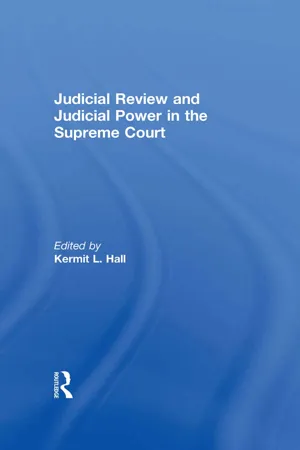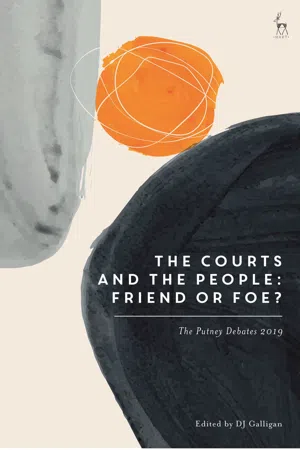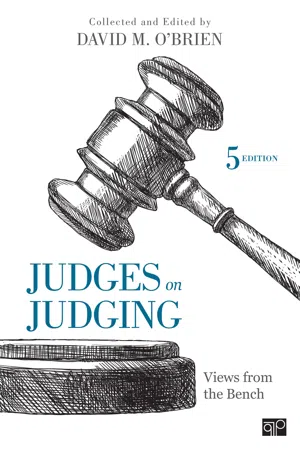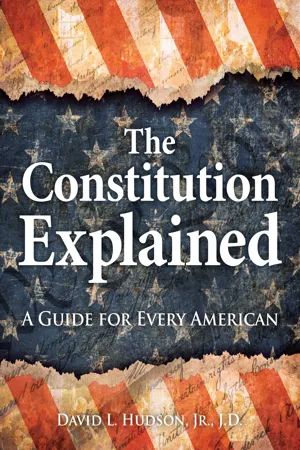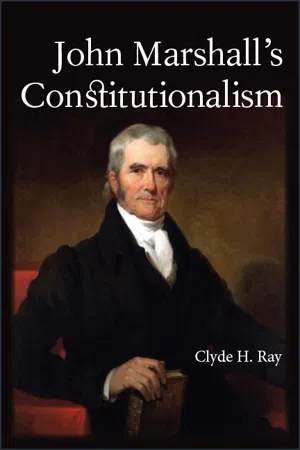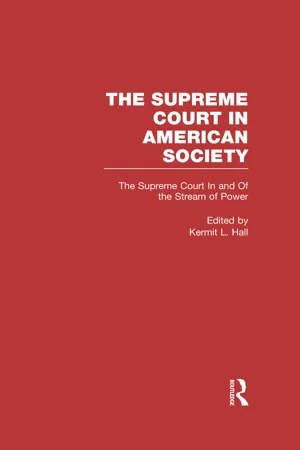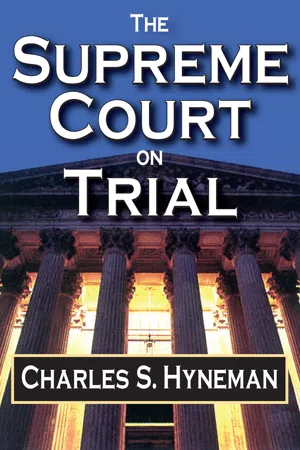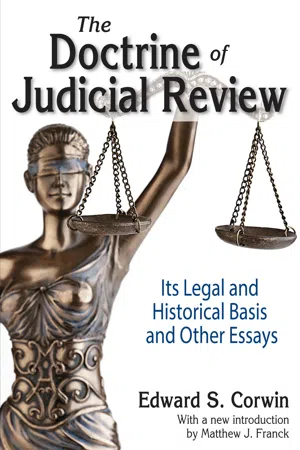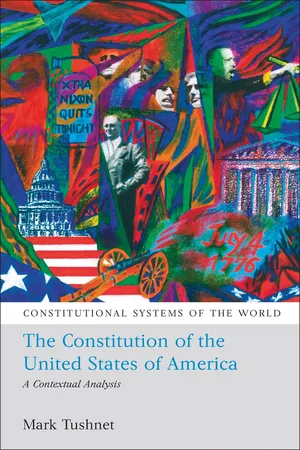Politics & International Relations
Marbury v Madison
"Marbury v. Madison" was a landmark 1803 U.S. Supreme Court case that established the principle of judicial review, giving the Court the power to declare laws unconstitutional. The case arose from a political dispute between outgoing President John Adams and incoming President Thomas Jefferson, and it set the precedent for the Court's role in interpreting the Constitution.
Written by Perlego with AI-assistance
Related key terms
10 Key excerpts on "Marbury v Madison"
- eBook - ePub
Judicial Review and Judicial Power in the Supreme Court
The Supreme Court in American Society
- Kermit L. Hall(Author)
- 2014(Publication Date)
- Routledge(Publisher)
OLUME 1969 JANUARY NUMBER 1A CRITICAL GUIDE TO MARBURY V. MADISON
WILLIAM W. VAN ALSTYNE *The concept of judicial review of the constitutionality of state and federal statutes by the Supreme Court is generally rested upon the epic decision in Marbury v. Madison. The controversies which have surrounded the exercise of this power by the Supreme Court require a periodic reexamination of the concept of judicial review at its source, the Marburyopinion. This article proceeds by examining the historical context in which the case arose and analyzes the opinion in terms of various alternative approaches which might have been util ized by Chief Justice Marshall. The specific holding of the case is isolated in contrast to later interpretation given it, and a collection of relevant historical materials is presented to lend insight into the constitutional viewpoints of the period.INTRODUCTION
T HE DECISION in Marbury v. Madison 1 was written under seemingly inauspicious circumstances. Its author, John Marshall, the fourth Chief Justice of the United States, had come to the Supreme Court without prior judicial experience and had served on the Court a scant three years before rendering this decision. Marshall was appointed to the post from the President’s cabinet as a second choice in the aftermath of a national election in which the President and his party had been deposed. The decision itself partly turned upon facts of which the Chief Justice had personal knowledge because of his previous involvement in the controversy while serving as Secretary of State. Though he wrote for a unanimous Court in Marbury v. Madison - eBook - ePub
The Courts and the People: Friend or Foe?
The Putney Debates 2019
- DJ Galligan, DJ Galligan(Authors)
- 2021(Publication Date)
- Hart Publishing(Publisher)
Marbury v Madison, which conclusively established the judicial power of review over laws of Congress and acts of the executive. The authority of the legislature, he stated, was constitutionally limited, it was the judiciaries’ duty to say what the law is, and any act of the legislature repugnant to the written Constitution is void.Although until this point, there had been no constitutional mandate for judicial supremacy, Marshall drew support for his position evident from the evolution of the American judicial tradition, and in the debates during the Constitutional Convention. Marbury v Madison was the convergence point for all contemporary ideas about the fundamental nature of law in America, that the moral restraint on government was legally enforceable.IV. THE MODERN COURT 1937–82The practice of judicial review has evolved over many years and through the decisions of many courts. The relatively modest power that judges asserted in the early years of the Constitution continued to grow as an important component of the American constitutional system. It was Congress, during much of the nineteenth century, that struggled to settle disputes regarding the proper exercise of authority of the federal government, especially relative to rights retained by the states. But as America entered the twentieth century, the courts became ever more involved with disputes with both Congress and the president, and there grew a more evident reflection of the tension between the judiciary, legislature and the executive.The controversial nature of the influence of the court over the legislature and the executive is illustrated in the often-cited Supreme Court case of Lochner v New York in 1905.11 The court struck down state legislation which limited, for health reasons, the numbers of hours bakers could work. The law, the court stated, violated the right of contract protected by the Fourteenth Amendment.Justice Oliver Wendell Holmes dissented, stating that the court needs to account for the force of public opinion, especially when recognised in legislation. The court should not strike down legislation merely because it offends the justices’ sense of reason or justice, but only if it can be shown to be a violation of principles that are long-standing and deeply held. - eBook - ePub
Judges on Judging
Views from the Bench
- David M. O′Brien(Author)
- 2016(Publication Date)
- CQ Press(Publisher)
Chapter 1 The Doctrine of Judicial ReviewMr. Marshall, Mr. Jefferson, and Mr. MarburyWarren E. BurgerChief Justice, Supreme Court of the United States (1969–1986) and Judge, U.S. Court of Appeals, District of Columbia (1956–1969)Lord Bryce once observed :I should add that in some quarters, the Supreme Court’s guardianship of that Ark probably has received more guarded praise than in distant places where its impact is purely theoretical. Lord Bryce, of course, had reference to the doctrine of judicial review, sometimes described as the doctrine of judicial supremacy, in the interpretation of constitutional terms and principles. . . .No feature of the government of the United States has awakened so much curiosity in the European mind, caused so much discussion, received so much admiration, and been more frequently misunderstood, than the duties assigned to the Supreme Court and the functions which it discharges in guarding the Ark of the Constitution.1It is helpful to an understanding of this subject to examine it in the setting in which Marbury v. Madison was decided in 1803 with all its momentous consequences for our country and to suggest to you that this great case had its antecedents in our colonial experience, and its taproots in the declarations of fundamental rights of Englishmen back to Magna Carta.Marbury v. Madison: Act One, the Setting
Very early in the history of our country the colonial experience of living under a parliamentary system with no check on the legislative or executive branch, except that of popular will in a limited way, led our Founding Fathers to feel strongly the need for limitations on all branches of government. The intellectual spadework for the system ultimately adopted for our federal government had been done, of course, by such seventeenth- and eighteenth-century political theorists as Hobbes and Locke.2 As we know, the great rationalist Montesquieu contributed the notion of a separation of powers within the government itself, in order that each branch might act as a sort of brake upon the others.3 As the system works today, one of the checks exercised by the Supreme Court involves measuring executive or legislative action against the Constitution whenever a challenge to such action is first properly brought within the framework of a “case” or “controversy,”4 and then properly brought within the “appellate jurisdiction”5 - eBook - ePub
The Constitution Explained
A Guide for Every American
- David L. Hudson(Author)
- 2022(Publication Date)
- Visible Ink Press(Publisher)
Marshall said that purely political questions are beyond the purview of the Court. This is called the political question doctrine, a matter discussed earlier in the chapter on the powers of the executive branch. However, Marshall wrote that where the executive “is directed by law to do a certain act affecting the absolute rights of individuals,” the court can declare a remedy for the harmed individual.Thus, so far, Marbury appeared to be winning the case. He had a right to the position, he deserved a legal remedy, and the Court had the power to issue the remedy. So why did he ultimately lose the case?He lost because Chief Justice Marshall determined that a section of the Judiciary Act of 1789 was unconstitutional. Marbury had reasoned that he had a right to sue directly in the U.S. Supreme Court, because Section 13 of the Judiciary Act of 1789 gave him this right. Marshall reasoned that Section 13 of the Judiciary Act of 1789 was unconstitutional because it conflicted with Article III of the Constitution, which did not give Marbury the right to sue directly in the U.S. Supreme Court.In other words, Section 13 of the Judiciary Act of 1789 gave the Supreme Court more types of original jurisdiction than did the language in Article III. Thus, Marshall reasoned that when a statute or law conflicts with the Constitution, the Constitution prevails. Marshall explained that Marbury should have filed in a lower federal court, not directly in the Supreme Court, writing, “the jurisdiction had to be appellate, not original.”The importance of Marbury v. Madison is that Marshall established that the judicial branch, most notably the U.S. Supreme Court, has the power to determine the constitutionality of the laws. In other words, a law repugnant to the Constitution is void and cannot be enforced or applied. This is the venerated power of judicial review.Power of Judicial Review
It is emphatically the province and duty of the judicial department to declare what the law is.—Chief Justice Marshall in Marbury v. Madison - eBook - ePub
- Clyde H. Ray(Author)
- 2019(Publication Date)
- SUNY Press(Publisher)
1John Marshall, Marbury v. Madison , and the Construction of Constitutional Legitimacy
P erhaps no other Supreme Court decision has offered a more lucid and forceful defense of the Constitution than Marbury v. Madison (1803). There are several explanations for the case’s prominence in American legal history, including the Court’s defense of the vested rights of individuals, its formulation of the “political questions” doctrine, and its assertion of judicial supremacy. For most scholars, the opinion’s articulation of the principle of judicial review continues to loom particularly large.1 All of these factors were indeed important in shaping the future course of the nation, and they are rightfully acknowledged in any assessment of the opinion’s impact. But they do not tell the whole story. To enter into a discussion of Marbury is above all to enter into John Marshall’s discussion of the fundamental authority of the Constitution. For in drafting the Court’s unanimous opinion, Marshall did more than artfully avoid a clash between the Federalist judiciary and its Jeffersonian critics. More important, he offered a detailed justification of the binding authority of the Constitution, mapping out justifications familiar if still undeveloped at the time of the decision. In examining these theories as well as his own, Marbury yields a purchase for surveying the assumptions implicit in contemporary arguments concerning constitutional legitimacy.Marshall’s own theory of constitutional legitimacy runs deeper than the concepts and language familiar to most Americans of his day. At the heart of his theory is a belief in the Constitution’s moral legitimacy, namely, its ability to provide fundamental law that, while perhaps not ideal, merits the respect and obedience of all citizens. Thus, while more familiar justifications based on rights, popular sovereignty, and the document’s settlement function help orient his view of constitutional legitimacy, Marshall’s theory of it includes at its center a subtle understanding of legitimacy inherent to the document itself. In justifying to his nineteenth-century audience his view of the Constitution’s authority, we find the first evidence of Marshall’s construction of a political theory that is distinctly his own, anchored neither to liberalism’s emphasis on individual rights nor to a republican common good. Instead, as described in Marbury - eBook - ePub
The Supreme Court In and Out of the Stream of History
The Supreme Court in American Society
- Kermit L. Hall(Author)
- 2018(Publication Date)
- Routledge(Publisher)
134 Yet, in the part of the opinion on this point, the Court ignored these suits. We can never know whether Marshall and his colleagues made a conscious decision to avoid mentioning conflicting precedent, but we can surmise that the persuasive Chief Justice convinced his associates that the new political situation demanded a new posture by the Court. A unified Federalist government no longer existed. The judicial branch remained the only hope of the Federalists to contain the dangers of majoritarian democracy. The repeal of the Judiciary Act of 1801 had just returned the jurisdiction of the federal courts to the more restricted version contained in the 1789 Act. It may have seemed like a small price to pay for the Court to give up a congressionally-enlarged original jurisdiction in order to maintain its supremacy by exercising judicial review in the context of appellate jurisdiction. If Marshall could persuasively maintain the Court's supremacy only by disregarding the precedents of the 1790's, his brethren probably gave him their blessing. Thus, the Chief Justice and the Court were willing to take liberties with the historical record to reach a decision they thought was essential to the survival of constitutional government.* Copyright © 1985 by Susan Low Bloch and Maeva Marcus. All rights reserved.** Susan Low Bloch, Associate Professor, Georgetown University Law Center; Maeva Marcus, Director, Documentary History Project, Supreme Court of the United States and Visiting Professor, Georgetown University Law Center. The authors with to thank Frank Flegal, Stephen Goldberg, John Kramer, Tom Krattenmaker, Jim Oldham, Roy Schotland, Warren Schwartz, Louis M. Seidman, Girardeau Spann, Mark Tushnet and Emily Van Tassel for their valuable comments on earlier drafts and Chris Celentino, David Eisenberg, Kate Harrison, Samia Rodriguez, Robert Teir, and Stephen Tuli for their helpful research assistance.1. 5 U.S. (1 Cranch) 137(1803).2. The case of Marbury v. Madison is studied in virtually every constitutional law and federal courts course, as well as many administrative law classes, it is reprinted in most casebooks on constitutional law, federal jurisdiction, and administrative law and is discussed in numerous books and articles. See. e.g., R. BERGER, CONGRESS V. THE SUPREME COURT (1969); 3 A. BEVERIDGE , THE LIFE OF JOHN MARSHALL 101-56 (1919); A. BICKEL, THE LEAST DANGEROUS BRANCH (1962); W. CROSSKEY, 1 & 2 POLITICS AND THE CONSTITUTION IN THE HISTORY OF THE UNITED STATES (1953); R. FAULKNER, THE JURISPRUDENCE OF JOHN MARSHALL 200-12 (1968); C. HAINES, THE AMERICAN DOCTRINE OF JUDICIAL SUPREMACY (2d ed. 1959); G. HASKINS & H. JOHNSON, 2 HISTORY OF THE SUPREME COURT OF THE UNITED STATES (1981); JUDICIAL REVIEW AND THE SUPREME COURT SELECTED ESSAYS (L. Levy ed. 1967); C. WARREN, THE SUPREME COURT IN UNITED STATES HISTORY (1922); Bice, An Essay Review of Congress v. The Supreme Court , 44 S. CAL. L. REV. 499 (1971); Corwin, Marbury v. Madison and the Doctrine of Judicial Review, - eBook - ePub
- Charles Hyneman(Author)
- 2017(Publication Date)
- Routledge(Publisher)
Enough of his opinion is quoted below to make clear how he established, first, that the Constitution is law supreme over all other expressions of law in the United States and, second, that the Supreme Court judges are to be guided by their own interpretation of the Constitution and to ignore every other expression of law which they are unable to reconcile with their interpretation of the Constitution. It can be argued, and some writers have made a great deal of this, that the Supreme Court judges did no more in Marbury v.Madison than declare a right to stand by the Constitution when a statute commands the Supreme Court to do something the Constitution expressly forbids the Supreme Court to do. According to this view, the Court did not, in Marbury v. Madison, announce that it would refuse to enforce an act in which the lawmakers violate a constitutional provision fixing limits on what the lawmakers may do. If there was uncertainty whether the Court would enforce laws which the judges think in excess of legislative power, that uncertainty was brought to an end by the third of our landmark decisions, the Dred Scott case (Scott v. Sanford, 19 Howard 393). This decision, announced in 1857, was the first after Marbury v. Madison in which the Supreme Court declared an act of Congress in conflict with the Constitution, and the point of conflict was not confined to the structure and jurisdiction of the judicial branch or the integrity of the Court itself. In this case, the Supreme Court held, by a vote of seven against two, that the statute known as the Missouri Compromise—which ruled slavery unlawful in certain territories of the United States—deprived slave-owners of their property without due process of law - eBook - ePub
- James Daley, James Daley, James Daley(Authors)
- 2012(Publication Date)
- Dover Publications(Publisher)
Marbury v. Madison1803
Following Thomas Jefferson’s defeat of John Adams in the presidential election of 1800, Adams went about appointing sixteen new circuit judges and forty-two new justices of the peace for the District of Columbia. However, when Adams failed to deliver four of the justices of the peace (including William Marbury) before his last day in office, Jefferson’s new secretary of state, James Madison, refused to give these four men their commissions. Marbury, in turn, called upon the Supreme Court to exercise a power Congress had bestowed upon it in the Judiciary Act of 1789 by issuing a writ of mandamus ordering Madison to deliver the four appointees to their commissions.It was the decision of the court that, because the jurisdiction bestowed upon it in the Judiciary Act was not enumerated in the Constitution, the Judiciary Act was null and void, and therefore the court did not have the authority to issue the requested writ of mandamus. The great significance of this case, however, comes from the fact that in order to reach this decision, the court found that it had the power and authority to review acts of Congress for their conformity to the Constitution.U.S. SUPREME COURT
MARBURY V. MADISON, 5 U.S. 137 (1803)
5 U.S. 137 (Cranch)WILLIAM MARBURY V. JAMES MADISON, SECRETARY OF STATE OF THE UNITED STATES.February Term, 1803AT THE December term 1801, William Marbury, Dennis Ramsay, Robert Townsend Hooe, and William Harper, by their counsel [5 U.S. 137, 138] severally moved the court for a rule to James Madison, secretary of state of the United States, to show cause why a mandamus should not issue commanding him to cause to be delivered to them respectively their several commissions as justices of the peace in the district of Columbia.This motion was supported by affidavits of the following facts: that notice of this motion had been given to Mr. Madison; that Mr. Adams, the late president of the United States, nominated the applicants to the senate for their advice and consent to be appointed justices of the peace of the district of Columbia; that the senate advised and consented to the appointments; that commissions in due form were signed by the said president appointing them justices, &c. and that the seal of the United States was in due form affixed to the said commissions by the secretary of state; that the applicants have requested Mr. Madison to deliver them their said commissions, who has not complied with that request; and that their said commissions are withheld from them; that the applicants have made application to Mr. Madison as secretary of state of the United States at his office, for information whether the commissions were signed and sealed as aforesaid; that explicit and satisfactory information has not been given in answer to that inquiry, either by the secretary of state, or any officer in the department of state; that application has been made to the secretary of the senate for a certificate of the nomination of the applicants, and of the advice and consent of the senate, who has declined giving such a certificate; whereupon a rule was made to show cause on the fourth day of this term. This rule having been duly served—[5 U.S. 137, 139] Mr. Jacob Wagner and Mr. Daniel Brent, who had been summoned to attend the court, and were required to give evidence, objected to be sworn, alleging that they were clerks in the department of state, and not bound to disclose any facts relating to the business or transactions of the office. - eBook - ePub
The Doctrine of Judicial Review
Its Legal and Historical Basis and Other Essays
- Edward S. Corwin(Author)
- 2017(Publication Date)
- Routledge(Publisher)
91A few months later occurred the decision in Marbury v. Madison , which against this background assumes its true color. Yet Marshall’s performance is by no means to be regarded as a work of supererogation. In the first place, vested as it was with the apparent authority of a judicial decision, it brought to an end a discussion which, for all that it had been highly favorable to judicial review, might in the end have proved unsettling. Again, it threw the emphasis once more upon the great essential considerations of the character of the Constitution, as “fundamental and paramount law” and “the province and duty of the judicial department to say what the law is.” Finally, in the very process of vindicating judicial review, it admitted to a degree the principle that had thus far been contended for only by opponents of judicial review. Thus, discussing the amenability of the President and his agents to mandamus, the Chief Justice says: “By the Constitution of the United States the President is vested with certain important political powers in the exercise of which he is to use his own discretion and is accountable only to his country in his political character and to his own conscience.”92 Later of course, this doctrine, which we may call the doctrine of departmental discretion , was supplemented by the doctrine that the powers of Congress must be liberally construed,93 and later still by the doctrine of the immunity of the President from judicial process.94 All these doctrines may be readily harmonized with the theory of judicial review.95 - eBook - ePub
The Constitution of the United States of America
A Contextual Analysis
- Mark Tushnet(Author)
- 2008(Publication Date)
- Hart Publishing(Publisher)
address the question of what the Constitution means in the circumstances. These reasons may be directly political, as when the Senate has to decide what its prerogatives are in the process of treaty abrogation, or normative and so indirectly political, when politicians internalize the proposition that they should take the Constitution seriously if only because their constituents expect them to do so. Second, there is good reason to think that those same factors give the political branches incentives to come up with reasonable albeit contestable constitutional interpretations.On this view, the political questions doctrine is tightly linked to the way in which ordinary politics operates. It thereby serves to coordinate the judicial branch and the political branches through judicially developed doctrine.STANDING
Chief Justice Marshall’s reference in Marbury to the courts’ role in vindicating individual rights generated what became known as the private-rights model of judicial review. In that model the courts’ power of judicial review could be invoked only by parties who suffered individualized injuries analogous to those redressed in ordinary common-law actions (akin to trespasses, for example, or a breach of contract, as in Marbury ), although sometimes those injuries could be widespread. Legislators who, in some other systems of judicial review, have privileged access to the courts, are no different from ordinary citizens in this regard; they too must allege that the statute ore executive action they are challenging somehow injures them in their capacity as legislators.37
Index pages curate the most relevant extracts from our library of academic textbooks. They’ve been created using an in-house natural language model (NLM), each adding context and meaning to key research topics.
